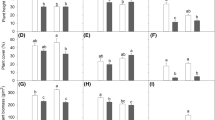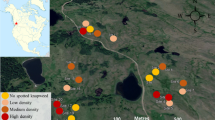Abstract
Invasion of native habitats by exotic plants often causes reductions in faunal diversity. However, there is little direct evidence of native fauna actively avoiding invaded habitat and few quantitative studies on the mechanisms underlying such avoidance. We quantified alterations made to the composition and physical structure of an Australian tropical savanna by grader grass (Themeda quadrivalvis); an understudied invasive grass that is associated with reduced faunal abundance and diversity. We found that grader grass profoundly changed the physical structure and floral composition of tropical savanna, forming dense lawn-like monocultures unlike the native savanna. Second, we investigated the habitat preferences of small ectotherms in partially invaded habitat, using a rainbow skink (Carlia schmeltzii) as a model system and discovered that they actively avoided grader grass. Finally, we experimentally tested predictions regarding mechanisms that may have driven the avoidance of grader grass. Predation rates and food availability were not likely the cause of grader grass avoidance, because experiments using models deployed in the field showed that predation rates were higher in native grass, and collection of invertebrates in both habitats indicated that prey availability was similar. However, mesocosm experiments on habitat selection in relation to vegetation structure, along with field measures of available operative environmental temperatures, suggested that small ectotherms probably avoid grader-grass-invaded savanna due to a suboptimal thermal environment and lack of appropriate habitat structural heterogeneity.




Similar content being viewed by others
References
Aerts R (1997) Climate, leaf litter chemistry and leaf litter decomposition in terrestrial ecosystems: a triangular relationship. Oikos 79(3):439–449. doi:10.2307/3546886
Baider C, Florens FBV (2011) Control of invasive alien weeds averts imminent plant extinction. Biol Invasions 13:2641–2646. doi:10.1007/s10530-011-9980-3
Bennett A, John-Alder H (1986) Thermal relations of some Australian skinks (Sauria: Scincidae). Copeia 1:57–64. doi:10.2307/1444888
Borgmann K, Rodewald A (2004) Nest predation in an urbanizing landscape: the role of exotic shrubs. Ecol Appl 14(6):1757–1765
Brooks KJ, Setterfield SA, Douglas MM (2010) Exotic grass invasions: applying a conceptual framework to the dynamics of degradation and restoration in Australia’s tropical savannas. Restor Ecol 18:188–197. doi:10.1111/j.1526-100X.2008.00470.x
Castilla A, Labra A (1998) Predation and spatial distribution of the lizard Podarcis hispanica atrata: an experimental approach. Acta Oecol 19(2):107–114
Christian K, Griffiths A, Bedford G (1996) Physiological ecology of frillneck lizards in seasonal tropical environment. Oecologia 106:49–56
Christian KA, Bedford G, Green B, Schultz T, Newgrain K (1998) Energetics and water flux of the marbled velvet gecko (Oedura marmorata) in tropical and temperate habitats. Oecologia 116:336–342. doi:10.1007/s004420050595
Christian K, Webb J, Schultz T (2003) Energetics of bluetongue lizards (Tiliqua scincoides) in a seasonal tropical environment. Oecologia 136(4):515–523. doi:10.1007/s00442-003-1301-9
Cook GD, Dias L (2006) TURNER REVIEW No. 12. It was no accident: deliberate plant introductions by Australian government agencies during the 20th century. Aust J Bot 54(7):601–625
Crooks JA (2002) Characterizing ecosystem-level consequences of biological invasions: the role of ecosystem engineers. Oikos 97:153–166. doi:10.1034/j.1600-0706.2002.970201.x
D’Antonio CM, Tunison JT, Loh RK (2000) Variation in the impact of exotic grasses on native plant composition in relation to fire across an elevation gradient in Hawaii. Austral Ecol 25:507–522. doi:10.1046/j.1442-9993.2000.01079.x
D’Antonio C, Vitousek P (1992) Biological invasions by exotic grasses, the grass/fire cycle, and global change. Annu Rev Ecol Syst 23:63–87. doi:10.2307/2097282
Davies K (2011) Plant community diversity and native plant abundance decline with increasing abundance of an exotic annual grass. Oecologia 167(2):481–491. doi:10.1007/s00442-011-1992-2
Douglas MD, O’Connor RA (2003) Effects of the exotic macrophyte, para grass (Urochloa mutica), on benthic and epiphytic macroinvertebrates of a tropical floodplain. Freshw Biol 48:962–971
Downes S, Hoefer A-M (2007) An experimental study of the effects of weed invasion on lizard phenotypes. Oecologia 153(3):775–785. doi:10.1007/s00442-007-0775-2
Eyre TJ, Wang J, Venz MF, Chilcott C, Whish G (2009) Buffel grass in Queensland’s semi-arid woodlands: response to local and landscape scale variables, and relationship with grass, forb and reptile species. Rangel J 31(3):293–305
Fairfax R, Fensham R (2000) The effect of exotic pasture development on floristic diversity in central Queensland, Australia. Biol Conserv 94:11–21
Fearn S, Trembath D (2009) Body size, food habits, reproduction and growth in a population of black whip snakes (Demansia vestigiata) (Serpentes: Elapidae) in tropical Australia. Aust J Zool 57:49–54
Foxcroft LC, Richardson DM, Rejmánek M, Pyšek P (2010) Alien plant invasions in tropical and sub-tropical savannas: patterns, processes and prospects. Biol Invasions 12:3913–3933. doi:10.1007/s10530-010-9823-7
Freifelder RR, Vitousek PM, D’Antonio CM (1998) Microclimate change and effect on fire following forest-grass conversion in seasonally dry tropical woodland1. Biotropica 30:286–297. doi:10.1111/j.1744-7429.1998.tb00062.x
Friend G (1993) Impact of fire on small vertebrates in mallee woodlands and heathlands of temperate Australia: a review. Biol Conserv 65:99–114
Furley P (2010) Tropical savannas: biomass, plant ecology, and the role of fire and soil on vegetation. Prog Phys Geogr 34(4):563–585. doi:10.1177/0309133310364934
Goldsbrough CL, Shine R, Hochuli DF (2006) Factors affecting retreat-site selection by coppertail skinks (Ctenotus taeniolatus) from sandstone outcrops in eastern Australia. Austral Ecol 31:326–336. doi:10.1111/j.1442-9993.2006.01561.x
Greenwood H, O’Dowd DJ, Lake PS (2004) Willow (Salix × rubens) invasion of the riparian zone in south-eastern Australia: reduced abundance and altered composition of terrestrial arthropods. Divers Distrib 10:485–492
Grice AC (2004) Weeds and the monitoring of biodiversity in Australian rangelands. Austral Ecol 29:51–58. doi:10.1111/j.1442-9993.2004.01364.x
Grice A (2006) The impacts of invasive plant species on the biodiversity of Australian rangelands. Rangel J 28:27–35
Groves R, Willis A (1999) Environmental weeds and loss of native plant biodiversity: some Australian examples. Aust J Environ Manag 6:164–171
Hättenschwiler S, Tiunov AV, Scheu S (2005) Biodiversity and litter decomposition in terrestrial ecosystems. Annu Rev Ecol Evol Syst 36:191–218. doi:10.1146/annurev.ecolsys.36.112904.151932
Husak JF, Macedonia JM, Fox SF, Sauceda RC (2006) Predation cost of conspicuous male coloration in collared lizards (Crotaphytus collaris): an experimental test using clay-covered model lizards. Ethology 112:572–580. doi:10.1111/j.1439-0310.2005.01189.x
Jackson J (2005) Is there a relationship between herbaceous species richness and buffel grass (Cenchrus ciliaris)? Austral Ecol 30:505–517. doi:10.1111/j.1442-9993.2005.01465.x
Jones C, Lawton J, Shachak M (1997) Positive and negative effects of organisms as physical ecosystem engineers. Ecology 78(7):1946–1957
Kanowski JJ, Reis TM, Catterall CP, Piper SD (2006) Factors affecting the use of reforested sites by reptiles in cleared rainforest landscapes in tropical and subtropical Australia. Restor Ecol 14:67–76
Keir A, Vogler W (2006) A review of current knowledge of the weedy species Themeda quadrivalvis (grader grass). Trop Grassl 40:193–201
Kutt AS, Fisher A (2010) Ant assemblages change with increasing dominance of an exotic pasture grass in a tropical savanna woodland. Ecol Manag Restor 11(1):67–69. doi:10.1111/j.1442-8903.2010.00517.x
Kutt A, Fisher A (2011) Increased grazing and dominance of an exotic pasture (Bothriochloa pertusa) affects vertebrate fauna species composition, abundance and habitat in savanna woodland. Rangel J 33:49–58
Kutt AS, Kemp JE (2012) Native plant diversity in tropical savannas decreases when exotic pasture grass cover increases. Rangel J 34:183–189. doi:10.1071/rj11048
Langkilde T, O’Connor D, Shine R (2003) Shelter-site use by five species of montane scincid lizards in south-eastern Australia. Aust J Zool 51(2):175–186
Liu J, Dong M, Miao SL, Li ZY, Song MH, Wang RQ (2006) Invasive alien plants in China: role of clonality and geographical origin. Biol Invasions 8:1461–1470. doi:10.1007/s10530-005-5838-x
Lloyd R, Alford RA, Schwarzkopf L (2009) Chemical discrimination among predators by lizards: responses of three skink species to the odours of high- and low-threat varanid predators. Austral Ecol 34:50–54. doi:10.1111/j.1442-9993.2008.01881.x
Mack RN (1981) Invasion of Bromus tectorum L. into Western North America: an ecological chronicle. Agro-Ecosyst 7:145–165. doi:10.1016/0304-3746(81)90027-5
Maerz J, Blossey B, Nuzzo V (2005) Green frogs show reduced foraging success in habitats invaded by Japanese knotweed. Biodivers Conserv 14:2901–2911. doi:10.1007/s10531-004-0223-0
Manicom C, Schwarzkopf L (2011) Diet and prey selection of sympatric tropical skinks. Austral Ecol 36:485–496. doi:10.1111/j.1442-9993.2010.02181.x
McLean CA, Moussalli A, Stuart-Fox D (2010) The predation cost of female resistance. Behav Ecol 21:861–867. doi:10.1093/beheco/arq072
Milton SJ (2004) Grasses as invasive alien plants in South Africa. S Afr J Sci 100(1):69–75
Mooney H, Cleland E (2001) The evolutionary impact of invasive species. PNAS 98(10):5446–5451. doi:10.1073/pnas.091093398
Newbold T (2005) Desert horned lizard (Phrynosoma platyrhinos) locomotor performance: the influence of cheatgrass (Bromus tectorum). Southwest Nat 50(1):17–23
Parr C, Ryan B, Setterfield S (2010) Habitat complexity and invasive species: the impacts of gamba grass (Andropogon gayanus) on Invertebrates in an Australian tropical savanna. Biotropica 42(6):688–696. doi:10.1111/j.1744-7429.2010.00637.x
Price B, Kutt AS, McAlpine CA (2010) The importance of fine-scale savanna heterogeneity for reptiles and small mammals. Biol Conserv 143:2504–2513. doi:10.1016/j.biocon.2010.06.017
Pyšek P, Jarošík V, Hulme PE, Pergl J, Hejda M, Schaffner U, Vilà M (2012) A global assessment of invasive plant impacts on resident species, communities and ecosystems: the interaction of impact measures, invading species’ traits and environment. Glob Change Biol 18:1725–1737. doi:10.1111/j.1365-2486.2011.02636.x
Rieder JP, Newbold TAS, Ostoja SM (2010) Structural changes in vegetation coincident with annual grass invasion negatively impacts sprint velocity of small vertebrates. Biol Invasions 12:2429–2439. doi:10.1007/s10530-009-9653-7
Rodda G, Fritts T, Chiszar D (1997) The disappearance of Guam’s wildlife. Bioscience 47(9):565–574
Rossiter NA, Setterfield SA, Douglas MM, Hutley LB (2003) Testing the grass-fire cycle: alien grass invasion in the tropical savannas of northern Australia. Divers Distrib 9:169–176. doi:10.1046/j.1472-4642.2003.00020.x
Rossiter N, Setterfield S, Douglas M, Hutley L, Cook G (2004) Exotic grass invasion in the tropical savanna of northern Australia: ecosystem consequences. Paper presented at the Fourteenth Australian Weeds Conference
Rossiter N, Setterfield S, Douglas M, Hutley L, Cook G (2006) The impact of exotic grass invasions on nitrogen cycling: a mini-review. Paper presented at the Fifteenth Australian Weeds Conference
Rout ME, Chrzanowski TH, Smith WK, Gough L (2013) Ecological impacts of the invasive grass Sorghum halepense on native tallgrass prairie. Biol Invasions 15:327–339. doi:10.1007/s10530-012-0289-7
Schmidt K, Schwarzkopf L (2010) Visible implant elastomer tagging and toe-clipping: effects of marking on locomotor performance of frogs and skinks. Herpetol J 20:99–105
Setterfield S, Douglas M, Hutley L, Ferdinands K, Ens E, Brooks K, Rossiter N (2008) Ecosystem impacts of an exotic grass in northern Australia: effects on structure and carbon stocks. Paper presented at the Sixteenth Australian Weeds Conference
Singh S, Smyth AK, Blomberg SP (2002) Thermal ecology and structural habitat use of two sympatric lizards (Carlia vivax and Lygisaurus foliorum) in subtropical Australia. Austral Ecol 27:616–623. doi:10.1046/j.1442-9993.2002.01222.x
Stellatelli O, Vega L, Block C, Félix C (2013) Effects on the thermoregulatory efficiency of two native lizards as a consequence of the habitat modification by the introduction of the exotic tree Acacia longifolia. J Therm Biol 38:135–142
Stuart-Fox DM, Moussalli A, Marshall NJ, Owens I (2003) Conspicuous males suffer higher predation risk: visual modelling and experimental evidence from lizards. Anim Behav 66:541–550. doi:10.1006/anbe 2003.2235
Thorp JR, Lynch R (2000) The determination of weeds of national significance. Commonwealth of Australia & National Weeds Strategy Executive Committee, Launceston
Valentine LE, Roberts B, Schwarzkopf L (2007) Mechanisms driving avoidance of non-native plants by lizards. J Appl Ecol 44:228–237. doi:10.1111/j.1365-2664.2006.01244.x
Vickers M, Manicom C, Schwarzkopf L (2011) Extending the cost-benefit model of thermoregulation: high-temperature environments. Am Nat 177(4):452–461. doi:10.1086/658150
Vitt LJ, Sartorius S (1999) HOBOs, Tidbits and lizard models: the utility of electronic devices in field studies of ectotherm thermoregulation. Funct Ecol 13:670–674
Vogler W, Owen N (2008) Grader grass (Themeda quadrivalvis): changing savannah ecosystems. Paper presented at the Sixteenth Australian Weeds Conference
Vorobyev M, Osorio D, Bennett A, Marshall NJ, Cuthill I (1998) Tetrachromacy, oil droplets and bird plumage colours. J Comp Physiol A Neuroethol Sens Neural Behav Physiol 183:621–633
Worthington E, Lowe-McConnell R (1994) African lakes reviewed: creation and destruction of biodiversity. Environ Conserv 21(3):199–213
Acknowledgments
Funding was provided by the School of Marine and Tropical Biology, James Cook University, and Queensland Agriculture, Fisheries and Forestry. James Cook University Animal Ethics Approval; A1618. DERM Scientific Purposes Permit; WITK08507710. We thank C. Manicom for sharing spectral data on Carlia and model lizard paint. We also thank Queensland Department of Environment and Resource Management (DERM) rangers for their support (N. Smith and family) and are grateful for the help we received in the field from D. Pike, A. Gourret and R. Duffy.
Author information
Authors and Affiliations
Corresponding author
Electronic supplementary material
Below is the link to the electronic supplementary material.
Rights and permissions
About this article
Cite this article
Hacking, J., Abom, R. & Schwarzkopf, L. Why do lizards avoid weeds?. Biol Invasions 16, 935–947 (2014). https://doi.org/10.1007/s10530-013-0551-7
Received:
Accepted:
Published:
Issue Date:
DOI: https://doi.org/10.1007/s10530-013-0551-7




